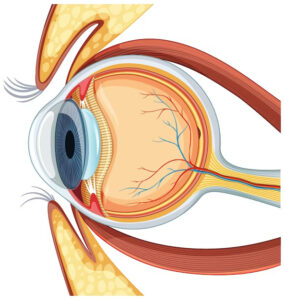IT’S NOT A PINK EYE, BUT YOUR EYES ARE PINK!
There are only so many ways your eyes can react to harm for PINK EYE, irritability, or infection. Redness or swelling can also be brought on by allergies or dry eyes.
Do not attempt to treat yourself for pink eye if you notice redness in the whites of your eyes. Call your optometrist instead for a thorough eye examination. A thorough examination of your eye health and eye care practises can aid in excluding eye disorders more severe than or similar to pink eye.
What Are Pink Eye’s Early Symptoms?
True conjunctivitis will cause your eyes to itch and turn pink or red, especially if it is bacterial or viral in origin. To prevent transmitting the condition to others, it’s critical to determine whether you have the bacterial or viral kind of this eye condition. Among the signs are:
- Swollen eyes
- Crusting across the eyelids, especially at night
- Excessive watering or tears
- Sensitivity to light
- Scratchy or itchy emotions
- Pink or red eye whites
- Pus or discharge from eyes
- Sensitivity to light
- Scratchy or itchy feelings
- Eye pain
Conjunctivitis can be brought on by allergens and chemicals in addition to bacterial or viral eye infections in the conjunctiva. Although they are not contagious, what is commonly misdiagnosed as pink eye they have the same capacity to irritate the conjunctiva and other regions of the eyes, resulting in pain, redness, swelling, and watering of the eyes.
WHAT TO LOOK FOR IN A PINK EYE
Any ailment that causes swelling or inflammation of the conjunctiva is referred to as pink eye or conjunctivitis. The translucent tissue layer that protects the whites of your eyes is called the conjunctiva.
Highly contagious, conjunctivitis is typically communicated by personal contact, coughing, sneezing, or touching a surface or object that has been touched by someone else. Regular hand washing and staying away from your face and eyes can help stop transmission.
Since there are various causes of pink eye, the signs and symptoms can differ. Pink eye’s general signs and symptoms include:
Symptoms of general conjunctivitis include redness (or pinkness) in the eye(s) and watery eyes.
- Feeling a foreign object in the eye(s)
- Discharge
- Crusty eyelids or eyelashes
- Swelling of the conjunctiva or eyelids
- Itching or burning
- Urge to touch the eye(s)
- Contact lenses feel uncomfortable or shift around a lot
Symptoms of Allergic Conjunctivitis
Your red eyes may occasionally be caused by allergies rather than pink eye. The symptoms of allergies typically involve both eyes. It frequently goes together with other allergy symptoms like:
- A sore throat
- Nasal discomfort (itchiness or runny nose),
- Asthma,
- sneezing
Allergies can be challenging and occasionally raise our risk of catching or spreading eye infections. When we experience allergy symptoms, we are more likely to reach out and touch our faces and eyes.
Children who suffer from allergies are especially at risk because they have a difficult time resisting the temptation to touch.
To protect their child’s eyes, adults should closely supervise the use of steroids if they are part of the treatment.
Call your optometrist for an eye exam if your child needs relief from itchy eyes. The best ways to treat symptoms and safeguard their eye health can be determined in collaboration with you by your eye care team.
a close-up of a woman’s closed eye showing a stye-related red, swollen eyelid
WHAT APPEARS TO BE A PINK EYE?
Although many eye disorders can first resemble pink eye, most eye conditions eventually manifest with their own symptoms. However, several eye conditions closely resemble pink eye and can make the diagnosis difficult.
When we lack the words to describe how our eyes feel or other symptoms, diagnosing eye health can occasionally be challenging. For instance, a more serious disease can be mistaken for something as simple as red eyes and impaired vision.
These eye diseases are frequently confused with pink eye, including:
Stye
A stye (hordeolum) is a sore lump brought on by a bacterial infection in an oil gland that has become plugged. The little, red lump may develop under your eyelid or at the root of your eyelash.

The following symptoms can occur:
- swollen eyelids,
- watery eyes,
- discharge,
- light sensitivity,
- gritty eye sensation,
- crusty eyelids or eyelashes,
- and blepharitis.
Bacteria buildup beneath your eyelashes and on your eyelids often results in blepharitis, which is brought on by inflamed or congested oil glands. It’s crucial to keep your skin and eyes clean to stop the growth of too many or hazardous microorganisms.
Blepharitis commonly manifests as redness in the eyes or eyelids and swelling.
- Dry eyes
- foamy tears
- blurry vision
- watery eyes
- light sensitivity
- burning or stinging
- eyelashes that fall off or grow in an unpredictably
- crusty eyelids or eyelashes.
Keratitis

An infection or injury can lead to keratitis, an inflammatory illness. The cornea, the translucent outer layer of your eye, will most likely be red or inflamed as a symptom.
The illness may or may not be contagious.
Keratitis symptoms include:
- Watery eyes; discharge
- cloudy vision
- sensitivity to light
- pain or itchiness
- iritis
Iris (the coloured portion of your eye) inflammation is known as anterior uveitis or iritis. The white of your eye may occasionally show signs of inflammation or redness, though. Iritis can affect one or both eyes, depending on the underlying reason, such as an accident.
Typical iritis symptoms include: Redness (of the iris or the front of the eye); Eye pain.
- Light sensitivity
- Floaters
- Blurred vision
- Vision loss
Glaucoma
The main cause of blindness in Canada is glaucoma, a group of diseases. The disorder affects the optic nerve, which is made up of nerve cells and is in charge of communicating what we see to our brain.

The symptoms of glaucoma vary since it has numerous causes. Typical signs of glaucoma include:
- Eye pain, tearing,
- blurry vision,
- loss of vision,
- haloes around lights
Misdiagnosed conditions as conjunctivitis
Individuals may disregard their pink eyes because the majority of individuals have had conjunctivitis of some kind due to colds, bacterial infections, allergies, or exposure to chemicals. However, there are additional conditions that can irritate the eyes. What is frequently mistaken for pink eye?
On the eyelids, sties are an infection that can irritate the eyes. These eyelid infections are brought on by bacteria invading the oil glands on the eyelids, which results in a lump. Risk factors for developing styes more frequently include the following:
- Touching the eyes with dirty hands;
- neglecting to properly clean contact lenses;
- using out-of-date eye makeup;
- Not removing eye makeup at night.
The majority of the time, styes disappear on their own in a few days and are not hazardous. However, they do share a number of symptoms with pink eye, which is why conjunctivitis may be mistakenly identified as the condition.
When to Visit a Doctor If You Have Pink Eye
You should consult a doctor if you or your child exhibits pink eye symptoms that are not brought on by a stye, an allergy, or exposure to chemicals. It is important to avoid self-diagnosing eye disorders because they could be communicable and lead to difficulties with the eyes.
Your doctor can examine you to identify whether you have bacterial or viral conjunctivitis. Eyedrops are available on prescription to help with the symptoms. Antibiotics may be administered to treat pink eye if a bacterial infection is the root cause. You should:
- to stop the spread.
- Wash your hands frequently,
- refrain from touching your eyes,
don’t share towels or other objects that come in contact with your face, don’t share cosmetics or drugs that are close to your eyes, and stay away from other people until the infection has cleared up.
Antibiotics cannot be used to treat the relatively common viral pink eye, which normally goes away on its own in two weeks. Styes typically do go away on their own, but if they do not start to clear up in 2-3 days, you may want to consult a doctor.


